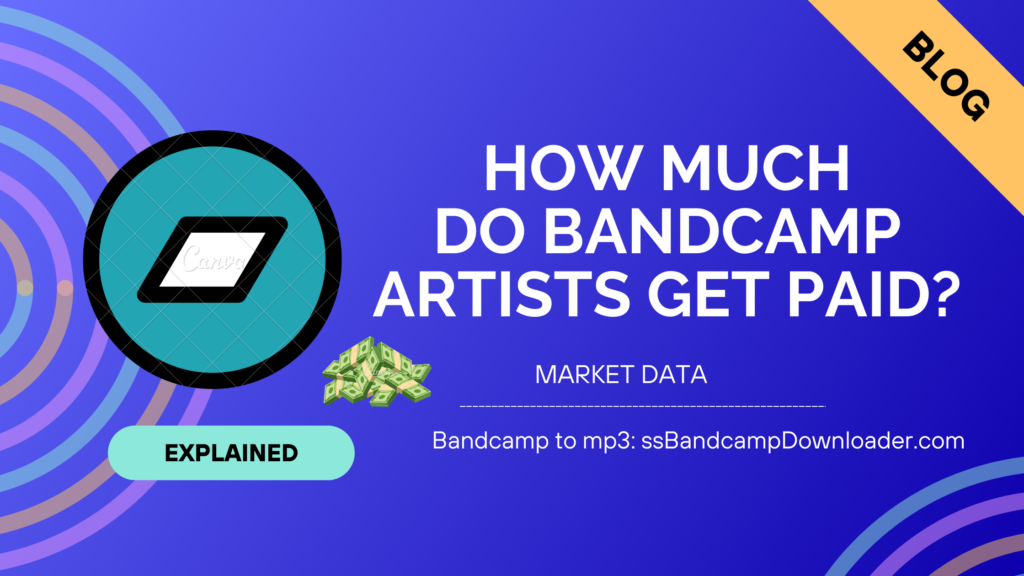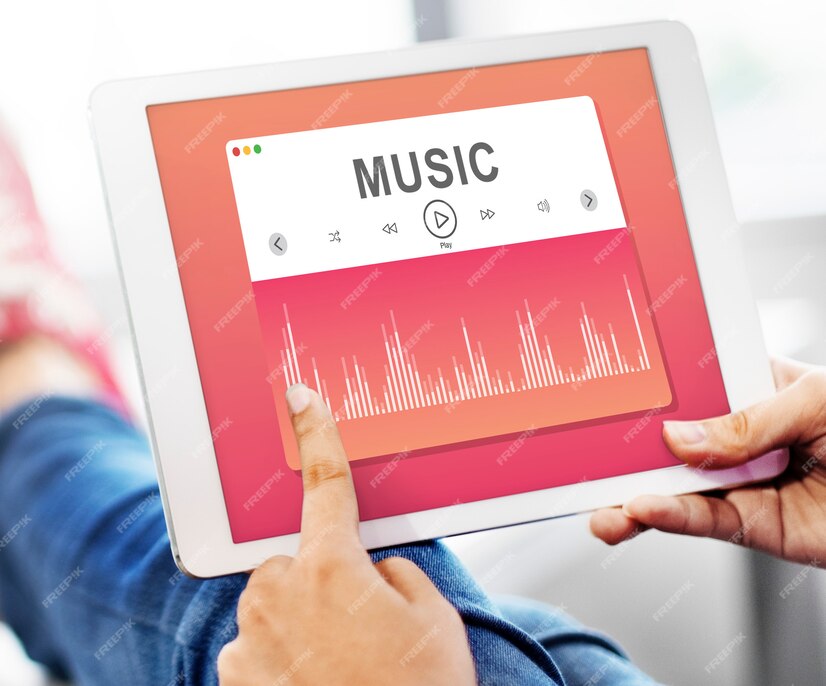In today’s digital age, the landscape of music distribution has evolved significantly, offering independent artists unprecedented opportunities. Among the platforms catering to these talents, Bandcamp stands out as a unique and artist-centric ecosystem. But do you know how much does Bandcamp pay artists?
As musicians seek to navigate this dynamic industry, understanding how much Bandcamp pays artists becomes a crucial piece of the puzzle.
This article delves into the heart of Bandcamp’s payment structure, providing artists with a clear and concise overview of how they can earn revenue on this platform. From sales to streaming, we’ll explore the inner workings of Bandcamp’s compensation model, shedding light on a subject that empowers musicians worldwide.

Bandcamp’s Revenue Model
Bandcamp’s revenue model is built around empowering independent artists and giving them a platform to directly connect with their fans. Unlike some other music distribution platforms, Bandcamp takes a distinct approach to generating income, primarily centered on the concept of direct-to-fan sales.
On Bandcamp, artists can sell both their music and merchandise directly to their audience. This direct-to-fan approach eliminates intermediaries, allowing artists to retain a more significant portion of their earnings. When fans purchase music or merchandise on Bandcamp, a substantial portion of the revenue goes directly into the artist’s pocket.
Furthermore, Bandcamp provides artists with a high degree of flexibility when it comes to pricing and payment options. This means musicians can choose to set their own prices for their music and merchandise, enabling them to experiment with different strategies to maximize their earnings.
The revenue generated through Bandcamp’s model is a refreshing departure from the traditional music industry’s structure, which often involves record labels and complex royalty arrangements.
With Bandcamp, artists have greater control over their financial destinies, making it an attractive platform for independent musicians seeking to monetize their work while building a dedicated fanbase.
Bandcamp’s Payment Structure

Bandcamp’s payment structure is designed to empower artists by offering them multiple avenues to earn revenue, primarily through sales and streaming. Let’s delve into the details of how artists can make money on this platform.
Sales Revenue on Bandcamp
When artists sell their music or merchandise on Bandcamp, they receive a significant share of the revenue. Bandcamp’s fee structure is transparent, with a revenue split that heavily favors the creators.
After Bandcamp deducts its processing fees (typically 10-15%), the rest of the money goes directly to the artist. This straightforward approach ensures that artists see a substantial portion of their earnings from each sale.
Streaming Revenue on Bandcamp
Bandcamp also offers a streaming service, but it operates differently from mainstream streaming platforms like Spotify or Apple Music. On Bandcamp, fans can stream an artist’s music for free, but they can also choose to purchase the tracks or albums if they wish.
Artists earn revenue not only from direct sales but also from these “name your price” streaming options. The exact amount artists receive per stream can vary, but the key takeaway is that every stream contributes to their potential earnings.
Pricing and Payment Options
One of Bandcamp’s notable features is its flexibility regarding pricing and payment options. Artists can set their own prices for their music and merchandise, allowing them to experiment with different strategies.
They can even offer “pay-what-you-want” pricing, where fans can choose how much they want to pay. This level of control empowers artists to tailor their approach to their unique fanbase and music style.
Overall, Bandcamp’s payment structure is artist-friendly, emphasizing transparency and direct financial benefits. It stands out as a platform that prioritizes the interests of musicians, making it an appealing choice for independent artists looking to monetize their creativity and connect with their audience.
Sales Revenue on Bandcamp
Sales revenue on Bandcamp is a crucial aspect of how artists can earn money on this platform. Bandcamp’s approach to selling music and merchandise provides independent artists with a transparent and artist-friendly revenue model.
When artists sell their music or merchandise on Bandcamp, they can retain a significant portion of the revenue generated from each sale. Here’s a breakdown of how sales revenue works on Bandcamp:
Transparent Fee Structure
Bandcamp operates with a transparent fee structure. Typically, the platform deducts a percentage (around 10-15%) as a fee to cover payment processing and hosting costs.
The remainder of the money from the sale goes directly to the artist. This means that artists receive a substantial share of the revenue generated from their work.
Direct-to-Fan Sales
Bandcamp’s model emphasizes direct-to-fan sales, meaning that artists can establish a direct connection with their audience.
Fans can purchase music and merchandise directly from the artist’s Bandcamp page, eliminating the need for intermediaries like record labels. This approach enables artists to have more control over their earnings and the way they interact with their supporters.
Flexible Pricing
Bandcamp offers artists the flexibility to set their own prices for their music and merchandise. This flexibility extends to the ability to implement “name your price” options, where fans can choose how much they want to pay.
Artists can experiment with different pricing strategies to find what works best for their unique fanbase and creative output.
Instant Gratification
Artists on Bandcamp can offer “instant gratification” tracks, allowing fans who pre-order an album to access certain songs immediately. This feature encourages pre-orders and can boost sales for artists.
Overall, sales revenue on Bandcamp provides artists with a transparent and artist-centric approach to monetizing their work. The platform’s commitment to ensuring that a significant portion of the revenue goes directly to the creators makes it an attractive choice for independent musicians looking to thrive in the digital music landscape.
Streaming Revenue on Bandcamp
Streaming revenue on Bandcamp offers an alternative approach compared to mainstream streaming platforms like Spotify or Apple Music. Bandcamp’s streaming model is unique and complements its focus on empowering independent artists. Here’s a closer look at how streaming revenue works on the platform:
Free Streaming with Purchase Option
On Bandcamp, artists can make their music available for free streaming to fans. This means that listeners can enjoy an artist’s tracks without having to pay. However, what sets Bandcamp apart is the option for fans to purchase the music if they choose to do so.
This “name your price” feature allows fans to directly support artists by buying the tracks or albums they enjoy.

Revenue from Streaming
While free streaming doesn’t generate direct revenue, it can contribute to artists’ earnings indirectly. When fans discover an artist’s music through streaming, they may be more inclined to make a purchase.
This means that even though streaming itself may not bring in immediate income, it can lead to sales, merchandise purchases, and increased fan engagement, all of which contribute to an artist’s overall revenue.
Unique Engagement Model
Bandcamp’s streaming model fosters a sense of engagement between artists and their fans. Unlike passive streaming on other platforms, Bandcamp encourages listeners to actively support the artists they enjoy by making a direct purchase.
This approach aligns with Bandcamp’s mission of being an artist-friendly platform that empowers musicians to connect directly with their audience.
Control Over Pricing
Artists have control over how they price their music for streaming on Bandcamp. They can offer a “pay-what-you-want” option or set specific prices for individual tracks or albums. This flexibility allows artists to experiment with different pricing strategies and cater to their fanbase’s preferences.
In summary, Bandcamp’s streaming revenue model is artist-centric and emphasizes the importance of direct fan support. While it may not provide immediate revenue through streaming alone, it creates opportunities for artists to build a dedicated fanbase and monetize their music through sales and merchandise. This unique approach aligns with Bandcamp’s commitment to empowering independent musicians in the digital music landscape.
Factors Influencing Earnings
Several key factors influence how much artists can earn on Bandcamp. Understanding these factors is essential for artists seeking to maximize their earnings on the platform:
Fanbase Size and Engagement
The size and engagement level of an artist’s fanbase play a significant role in determining their earnings. Artists with a larger, more dedicated following are likely to generate more sales and streams. Engaging with fans through social media, email newsletters, and live performances can help nurture a supportive and loyal audience.
Pricing Strategies
Artists have the freedom to set their own prices for music and merchandise on Bandcamp. Choosing the right pricing strategy is crucial.
Some may opt for a “pay-what-you-want” approach to encourage fan contributions, while others may set fixed prices for their work. Experimenting with pricing and understanding what resonates with their audience can impact an artist’s revenue.
Discounts and Promotions
Bandcamp allows artists to run promotions and offer discounts on their products. Timing these promotions strategically can boost sales. Artists may choose to offer discounts during special occasions, album releases, or to reward their loyal fans.
Quality of Content
The quality of an artist’s music and merchandise matters. High-quality recordings and compelling merchandise can attract more fans and increase the likelihood of sales. Investing in professional production and design can pay off in the long run.
Release Frequency
Consistency in releasing new music can keep fans engaged and returning to an artist’s Bandcamp page. Frequent releases, such as singles, EPs, or albums, can help maintain visibility and generate continuous revenue.
Collaborations and Networking
Collaborating with other artists or participating in Bandcamp’s community events can expand an artist’s reach. Networking and building relationships within the Bandcamp community can lead to cross-promotional opportunities and increased exposure.
Genre and Niche
The genre and niche an artist operates in can impact their earnings. Some genres and niches may have a more dedicated and supportive fanbase on Bandcamp, while others may face more competition. Artists should consider the platform’s demographics and their target audience when planning their strategy.
Fan Engagement and Interaction
Engaging with fans on Bandcamp through comments, messages, and exclusive content can create a deeper connection. Fans who feel a personal connection with an artist are more likely to support them by making purchases.
In conclusion, artists’ earnings on Bandcamp are influenced by a combination of factors, including the size and engagement of their fanbase, pricing strategies, content quality, release frequency, collaborations, genre, and fan interaction. By carefully considering and optimizing these elements, artists can enhance their revenue potential on the platform.
Payout Frequency and Minimum Threshold
Bandcamp’s payout frequency and minimum threshold are essential aspects to understand for artists looking to receive their earnings from the platform. Here’s an overview of how these factors work:
Payout Frequency:
Bandcamp offers a straightforward payout schedule. Artists can choose to receive their earnings on a monthly or weekly basis. This flexibility allows artists to select the payout frequency that aligns with their financial needs and preferences.
- Monthly Payout: This option provides a regular monthly payout, making it suitable for artists who prefer a consistent income stream.
- Weekly Payout: Artists who wish to receive their earnings more frequently can opt for the weekly payout. This option can be especially beneficial for those who have a steady flow of sales and want quicker access to their funds.
Minimum Threshold:
To request a payout on Bandcamp, artists need to meet a minimum earnings threshold. This threshold ensures that payouts are efficient and cost-effective. The minimum threshold may vary depending on the artist’s location and the payout method chosen. Here’s how it typically works:
- Minimum Threshold Amount: Bandcamp sets a specific minimum earnings threshold (e.g., $20) that an artist must reach before they can request a payout.
- Payout Method: Artists can choose from various payout methods, such as PayPal, bank transfer, or check. Each method may have different minimum thresholds.
- Accumulation of Earnings: Until an artist’s earnings exceed the minimum threshold, the funds remain in their Bandcamp account. Once the threshold is met, the artist can request a payout.
- Timing of Payout: Payouts are typically processed at the end of the chosen payout period (monthly or weekly).
It’s important for artists to keep track of their earnings and ensure they meet the minimum threshold for their selected payout method. Additionally, understanding the payout frequency options allows artists to manage their finances effectively, whether they prefer regular monthly payouts or more frequent weekly ones.
In summary, Bandcamp provides artists with flexibility in choosing their payout frequency (monthly or weekly) and sets minimum earnings thresholds for efficient processing. Artists should consider their financial needs and the threshold requirements when deciding on their preferred payout schedule and method.
Transparency and Artist-Friendly Approach

Bandcamp is renowned for its transparency and artist-friendly approach, making it a standout platform for independent musicians. Here’s an exploration of how these principles are embedded in the platform’s ethos:
1. Transparent Fee Structure:
Bandcamp operates with a clear and transparent fee structure. When artists make sales, the platform deducts a percentage (usually 10-15%) to cover payment processing and hosting fees.
The remaining revenue goes directly to the artist. This level of transparency ensures that artists know exactly how much they will earn from each sale, promoting trust and predictability.
2. Direct-to-Fan Sales:
One of Bandcamp’s defining features is its emphasis on direct-to-fan sales. Artists can interact directly with their audience, enabling them to establish a personal connection.
This approach eliminates the need for intermediaries like record labels, ensuring that artists retain a substantial portion of their earnings.
3. Flexibility in Pricing:
Bandcamp gives artists the freedom to set their own prices for music and merchandise. This flexibility allows musicians to experiment with different pricing strategies, including “pay-what-you-want” options, which can encourage fan contributions. Artists can adapt their pricing to suit their unique creative output and fanbase.
4. Artist Control:
Bandcamp empowers artists by giving them control over their content and how it’s presented. Artists can customize their Bandcamp pages, add liner notes, lyrics, and bonus material, providing fans with a rich and engaging experience.
5. Regular Communication:
Bandcamp maintains an open line of communication with artists through blog posts, emails, and other channels. They often announce updates, promotions, and initiatives that benefit musicians, keeping the artist community informed and engaged.
6. Support for Charitable Causes:
During special events like “Bandcamp Fridays,” the platform has waived its revenue share to help artists generate more income. It has also encouraged artists to donate proceeds to charitable causes, demonstrating a commitment to social responsibility.
7. Feedback and Engagement:
Bandcamp actively seeks feedback from artists and fans, using this input to refine its platform and policies. This responsive approach ensures that Bandcamp remains aligned with the needs and desires of the artist community.
In summary, Bandcamp’s transparency, direct-to-fan sales, pricing flexibility, artist control, regular communication, support for charitable causes, and engagement with the artist community create an environment that genuinely prioritizes the interests of independent musicians. This artist-friendly approach has solidified Bandcamp’s reputation as a platform that not only provides a space for artists to showcase their work but also supports their creative and financial success.
Case Studies
Case studies provide real-world examples of how artists have benefitted from Bandcamp’s platform. These success stories illustrate the platform’s effectiveness in supporting musicians. Here are a few compelling case studies:
1. Khruangbin:
Khruangbin, a globally acclaimed instrumental band, has experienced remarkable success on Bandcamp. They strategically used the platform to release exclusive content, including demos and remixes, to their dedicated fanbase. By engaging with their fans directly and offering unique content, they’ve cultivated a loyal following and generated significant revenue on Bandcamp.
2. Amanda Palmer:
Amanda Palmer, a singer-songwriter known for her engagement with fans, utilized Bandcamp to connect on a personal level. She offered “pay-what-you-want” pricing for her album “Theatre Is Evil,” allowing fans to decide the value of her work. This approach resulted in a highly successful crowdfunding campaign, with fans contributing generously, leading to a substantial income.
3. Run the Jewels:
Hip-hop duo Run the Jewels partnered with Bandcamp to release exclusive merchandise alongside their music. By offering limited-edition vinyl records and other collectibles directly to fans on the platform, they not only generated significant revenue but also built a sense of exclusivity and engagement with their audience.
4. Sufjan Stevens:
Sufjan Stevens utilized Bandcamp to release his ambient album “Convocations” during the COVID-19 pandemic. He not only made the album available for free streaming but also offered it for sale with all proceeds going to charity. This approach showcased Bandcamp’s versatility in supporting charitable causes while allowing artists to connect with their fans.
5. Bell Witch and Aerial Ruin:
Doom metal band Bell Witch and neofolk artist Aerial Ruin collaborated on the album “Stygian Bough: Volume I” and released it on Bandcamp. By combining their unique styles and using Bandcamp’s platform to reach their respective audiences, they not only received critical acclaim but also earned income directly from sales and streaming.
These case studies highlight how a diverse range of artists, from instrumental bands to singer-songwriters and hip-hop duos, have harnessed Bandcamp’s artist-friendly features to engage with fans, offer exclusive content, and generate revenue. Bandcamp’s flexible approach enables artists to tailor their strategies to their unique styles and fanbases, resulting in success stories that underscore the platform’s effectiveness in supporting musicians’ creative and financial endeavors.
Criticisms and Challenges
While Bandcamp is widely praised for its artist-centric approach, like any platform, it faces criticisms and challenges that artists should be aware of:
1. Limited Discovery Features:
One common criticism is that Bandcamp’s discovery features may not be as robust as those of major streaming platforms. Artists may find it challenging to reach new audiences organically on the platform, and discoverability can be a hurdle.
2. Competition:
Bandcamp hosts a vast number of artists and releases, which can result in fierce competition for attention. It’s essential for artists to stand out and promote their work effectively within the platform.
3. Pay-What-You-Want Pricing:
While the “pay-what-you-want” pricing option can be advantageous, some artists may find it challenging to set a price that strikes a balance between fan contributions and revenue generation.
4. Platform Dependency:
Artists who rely solely on Bandcamp for distribution may feel vulnerable to any changes in the platform’s policies or fee structures. Diversifying their distribution strategy might be a consideration.
5. Limited Streaming Revenue:
Bandcamp’s streaming model, while artist-friendly in many ways, may not provide as substantial streaming income as some mainstream platforms. Artists looking for significant streaming revenue might need to consider other platforms alongside Bandcamp.
6. Marketing and Promotion Effort:
Bandcamp puts a significant emphasis on direct engagement with fans, which means artists need to invest time and effort in marketing and promotion. Some musicians may find this aspect challenging or time-consuming.
7. Genre and Audience:
Bandcamp’s audience tends to vary by genre, with some genres and niches being more prominent on the platform than others. Artists need to consider whether their music aligns with Bandcamp’s user base.
It’s important to note that while Bandcamp has its challenges and criticisms, many artists find it to be a valuable tool for connecting with fans and generating revenue. The platform’s transparency, flexibility, and direct-to-fan approach make it an attractive option for independent musicians. Artists should carefully assess how Bandcamp fits into their overall music distribution strategy, considering both its advantages and limitations.
Conclusion
In conclusion, Bandcamp stands as a beacon of transparency and empowerment for independent artists in the digital music landscape. Its artist-friendly approach, including flexible pricing, direct-to-fan sales, and frequent payouts, fosters an environment where creativity thrives and musicians can directly connect with their supporters.
Real-world case studies showcase the platform’s effectiveness in elevating artists’ careers. While facing challenges like discoverability and competition, Bandcamp’s commitment to supporting musicians remains unwavering.
For artists seeking a platform that prioritizes their financial success and artistic autonomy, Bandcamp remains a compelling choice, offering a unique path to recognition, engagement, and revenue in today’s dynamic music industry.
FAQs
Bandcamp’s artist payouts are notably higher compared to traditional streaming platforms. While Spotify pays artists based on the number of streams, Bandcamp allows artists to set their prices and retain a significant portion of the revenue, often around 85-90% after fees.
Yes, Bandcamp deducts a percentage (typically 10-15%) from sales to cover payment processing and hosting costs. However, the remaining revenue goes directly to the artist, ensuring transparency and fairness.
Yes, artists can sell merchandise such as t-shirts, vinyl records, and posters alongside their music on Bandcamp. This offers a comprehensive platform for artists to engage with fans and generate additional income.
Artists can choose to receive their earnings on Bandcamp either monthly or weekly, providing flexibility to align with their financial needs and preferences.
Bandcamp hosts a diverse range of music genres, but some niches may be more prominent than others. Artists should assess whether their music aligns with Bandcamp’s user base and consider it as part of their distribution strategy, especially if they have a loyal and engaged fanbase on the platform.
